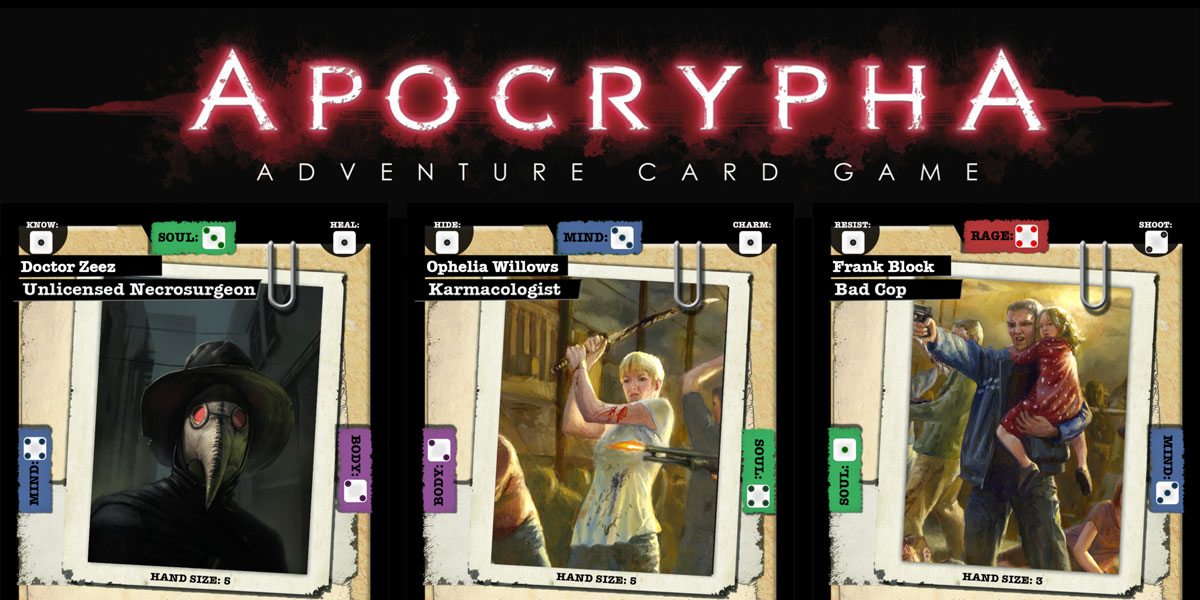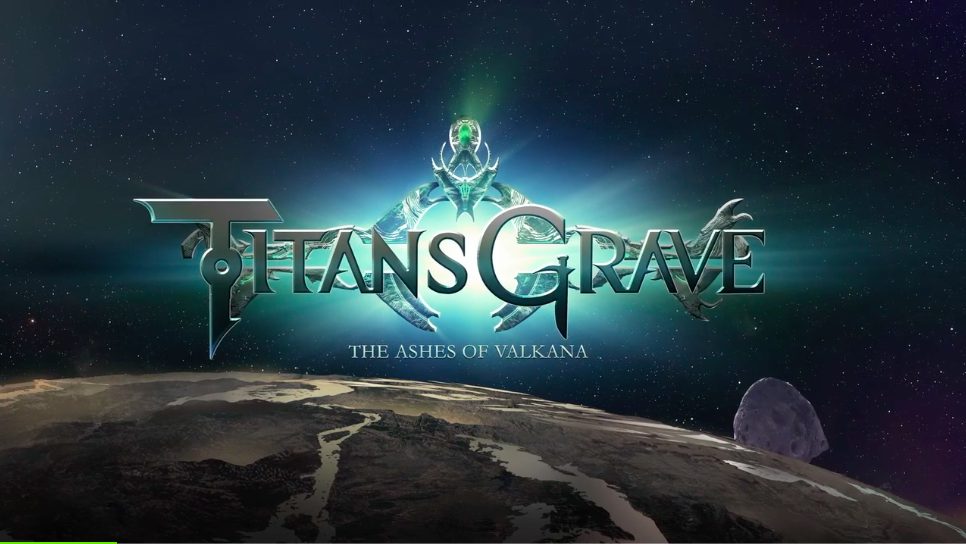Three years ago at GameStorm, I met this guy named Mike Selinker and played a demo of his cooperative card game (at the time called Saints). Some of the ideas from that game eventually became the Pathfinder Adventure Card Game, but Selinker still had some more tricks up his sleeves. Today, we finally get to see what he’s been up to: Apocrypha.
At a glance: Apocrypha is an adventure card game for 1 to 6 players, ages 13 and up, and takes about an hour per session. But it’s also a role-playing game, so you can add a gamemaster to the player count–this will also likely increase the length of the game. The game can be played as a card game (like Pathfinder Adventure Card Game) or more like a traditional RPG with a gamemaster. It just launched on Kickstarter today; the pledge level for a copy of the base game (including the first chapter) is $66, or you can pledge $99 to include all additional chapters unlocked during the campaign.
Note: if you pledge for a copy of the game today, you’ll get an exclusive promo card–and if you’re among the first 200 backers, it’ll be signed by Mike Selinker! I tell you this now, in case you want to pop over there now and come read the rest after.
New to Kickstarter? Please read our crowdfunding primer.
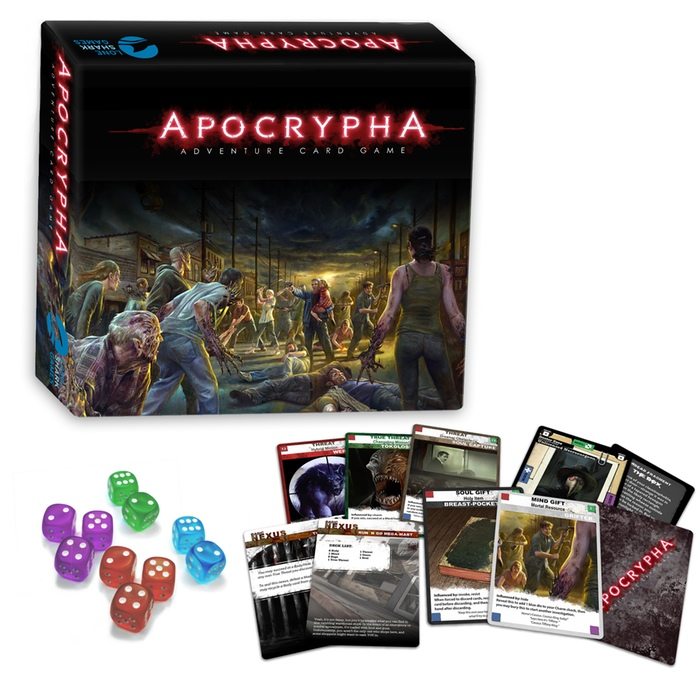
Components:
The exact component count is subject to change, but it will contain at least 500 cards (the base set plus the first “chapter”), 16 six-sided dice, and character tokens. Each additional chapter will include about 75 cards, and if all stretch goals are unlocked, there will be nine chapters total, counting the one that’s included in the base set.
The cards in the base set will include: characters, nexuses, masters, minions, death fragments, omens, threats, gifts, templates, and generic fragments. The chapter decks will include chapter-specific nexuses, masters, minions, fragments, threats, and gifts. Selinker said he wanted to avoid covering up cool artwork with numbers and text, so numbers and game text have been moved to the corners of most cards to allow more room for the artwork to stand on its own. (Ideally this doesn’t make the cards too difficult to read. I’ve been informed that the four skill icons will use different shapes instead of just the squares seen here, to make the game more color-blind friendly. That, and the four skills will always be in the same locations on all the cards.)

For those of you familiar with the Pathfinder Adventure Card Game, some of the cards have a rough correspondence:
- nexus = location
- master = villain
- minion = henchman
- omen = blessing
- threat = bane
- gift = boon
There are other cards in Apocrypha, however, that don’t have a 1:1 correspondence to cards in PACG.
Another thing Selinker told me was that every card in Apocrypha will have flavor text on it. He really wants the story to be an integral part of the game, so everything has a little bit of text on it. A particular example of this is in the fragments–these are cards that you get after completing missions. Each one represents a fragment of a repressed memory that comes back to you and it gives you additional abilities … and penalties. The text on these fragments are like little short stories, and among the stretch goals for the campaign are memory fragments written by a host of authors, including GeekDad’s own Matt Forbeck. (I’ve gotten a sneak peek at the other authors on the list, and it’s pretty exciting–we’ll update the post if we get permission to post it.)
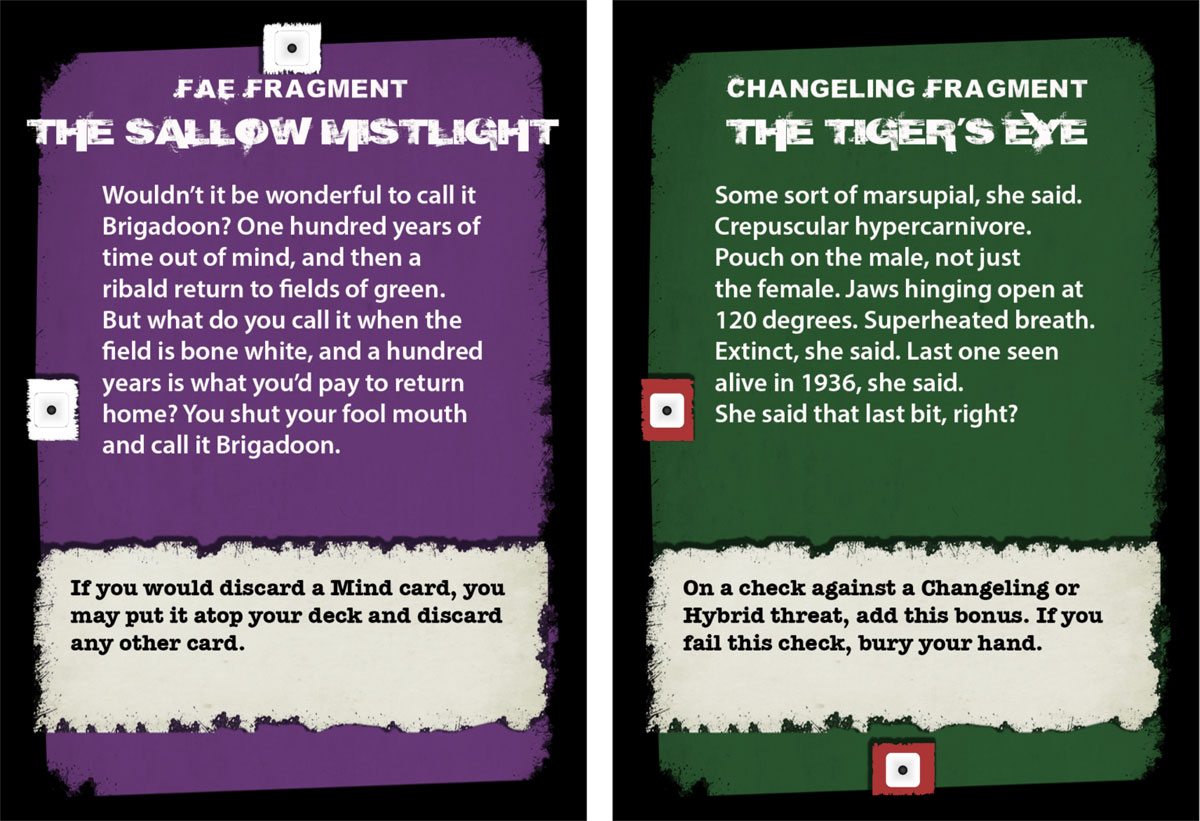
The Theme
The story is set in today’s world, though one that is full of monsters. However, most people can’t see them because of something called the Paradigm. But there are those–called “saints”–who can see the monsters, and have teamed up to fight them. (That’s you, by the way.) There are nine different entities–the Novem–who are trying to break the Paradigm, and each chapter of the game will deal with one of these. The first chapter features Keiros the werewolf lord and his shapeshifting minions.
The Card Game
Now, I haven’t gotten to play a complete version of the game yet–I played a very early version a few years ago, and I’ve seen some of the cards in the new revamped system, but more details will be revealed as the Kickstarter campaign progresses. If you’ve played the Pathfinder Adventure Card Game, some of Apocrypha will seem familiar, but for the purposes of this review I’ll assume you’re new to the idea of an adventure card game.
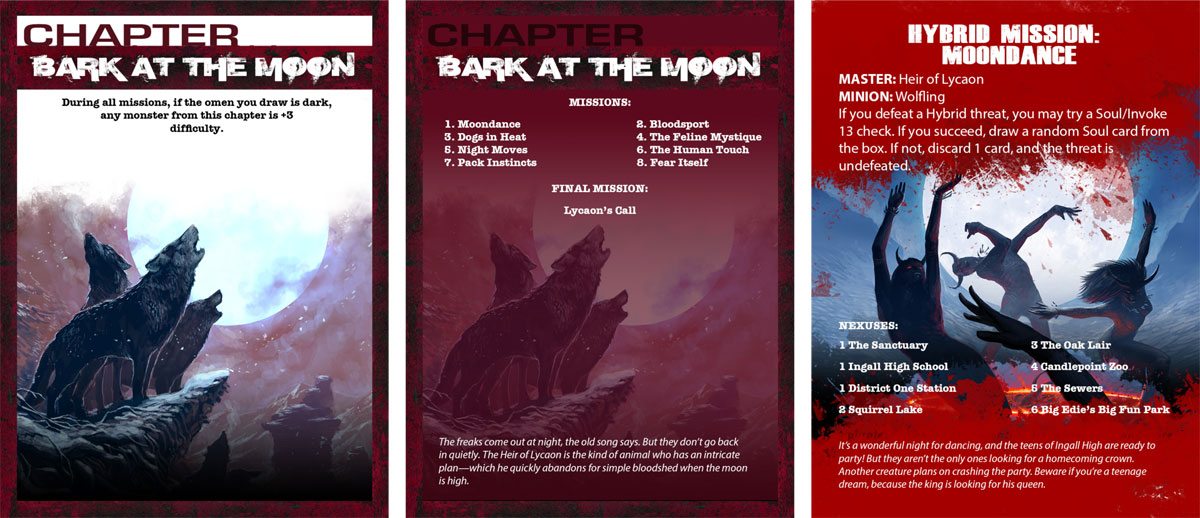
The objective of the game is to work together to track down the big bad guy–the master–and corner it in a nexus and defeat it. The game will consist of nine chapters, and each chapter will have a number of missions. The missions can be completed in any order, but the final mission is to thwart the toughest master, which will be much harder if you haven’t beaten the other missions first. In Apocrypha, you can even play the chapters in any order that you want–there are some base set cards that can be used in any chapter, and others that are chapter-specific, so if you’re in the land of werewolves you won’t necessarily have vampires and zombies popping up inexplicably. Unless you want them to.
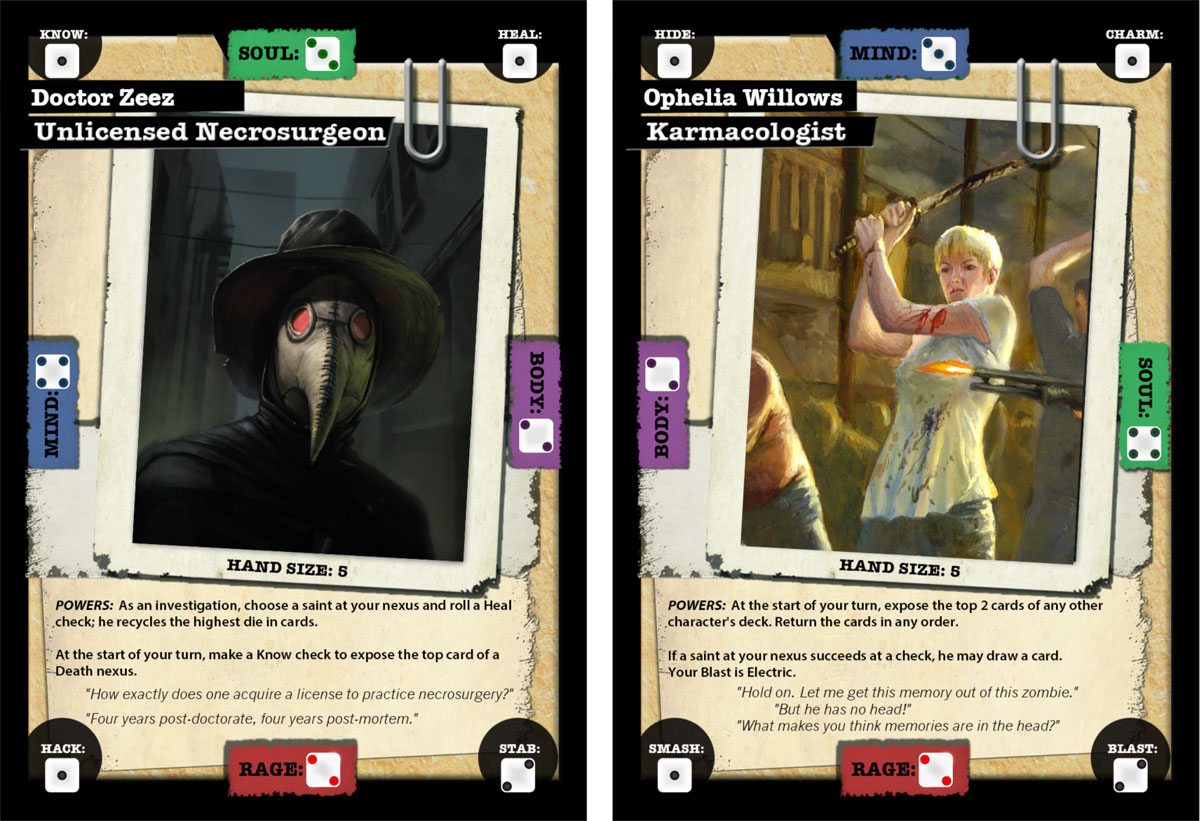
Each person will start with a character card, and will keep this character card as they play through the various missions (unless they die, but more about that later). Each character has four natural skills called “virtues” (Body, Mind, Soul, and Rage) on the edges of the card, and four learned skills on the corners, plus some other information in the middle: hand size and powers. The idea is that when you take an action that requires a skill, the icon shows you how many dice to roll–though of course these can also be affected by other cards. If you use one of your learned skills for something, you add that number on the corner to either of the natural skills next to it.
Another new feature about these skills is that the location on the card matters: the skill on the right and left can be accessible to your teammates on your right and left, respectively. The power on the bottom of the card points to you and only affects you, while the one on the top can affect others at your location. These directional effects will also apply to the memory fragments you’ll gain.
The virtues on your character also determine the number of cards of each type that will go into your deck when you begin. Each character has a deck of cards of various types–the deck represents your equipment and abilities, but it’s also your life–run out of cards, and you’ll get a death fragment at the end of the mission. Too many death fragments, and that character dies.
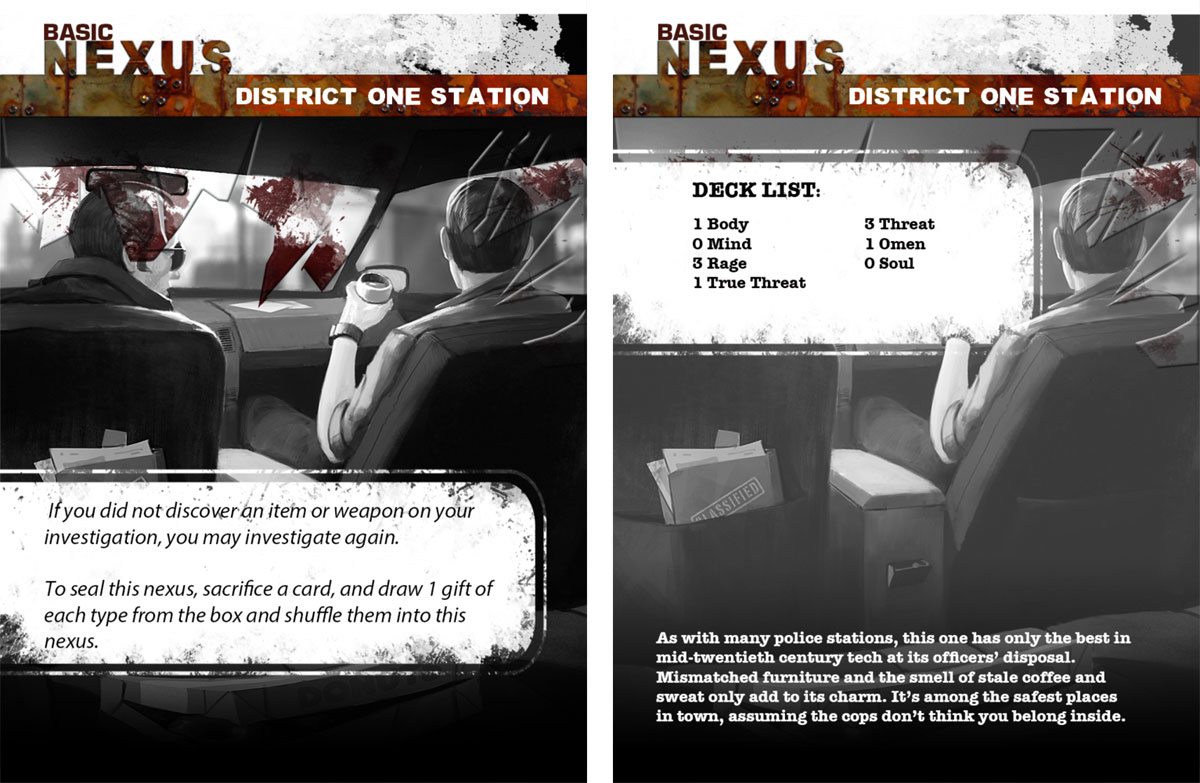
Each mission will have some number of nexuses that you’ll need to investigate. Each nexus card has some rules that apply to it, some flavor text on it, and a list of card types that will go into it. You’ll move from nexus to nexus as you search for the master and try to collect some gifts to help you.

Omens serve a number of purposes. First, there’s a deck of omen cards that acts as a timer for the game. On each turn, you’ll draw an omen from the deck. If the omen deck runs out, time’s up and you all lose. Some omens are good and some are bad. You can hang onto the omen for later, or you can sacrifice it to investigate–but that omen will affect your turn somehow. And then, after they’ve been used, they’re returned to the box, rather than going back into your deck.
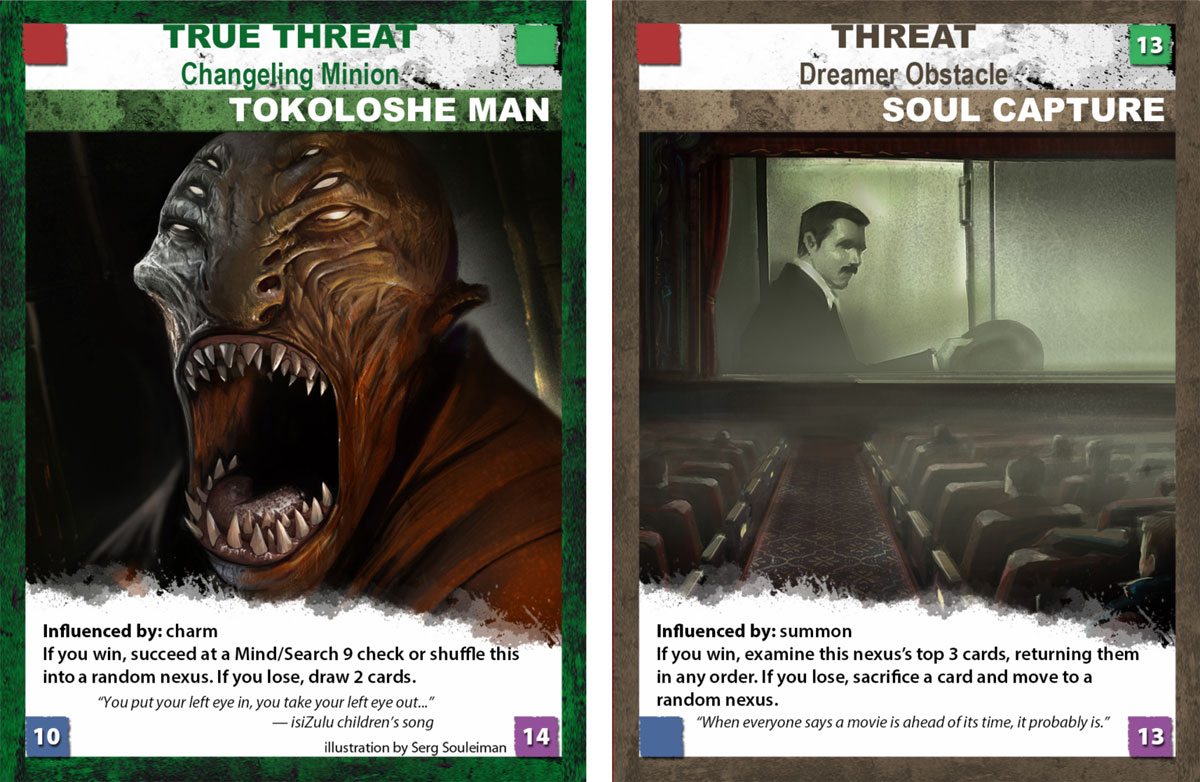
Of course, along the way, you’ll run into bad guys and traps and obstacles and other things you’ll need to overcome: these are the threats. Some of the icons in the corners have numbers–that indicates which skills you can use to fight it, as well as the number you’ll need to succeed. In addition, some are influenced by learned skills, so if you have a skill that applies, you can add that as well. There are also good things that you can acquire, called gifts, with similar requirements for obtaining them.

Once you’ve finished a mission, you’ll gain a fragment–either a memory fragment or a death fragment–and add it to your character. Your character is represented by a 3×3 grid of cards, with the character in the middle and the fragments in the spaces around it. As with the character skills, the fragments will add bonuses as indicated by the dice icons on the edges–but since each character’s skills are arranged differently, fragments will boost different skills for different characters. In addition, some cards may be able to boost cards next to them, or else other characters to your left and right, depending on the placement of the cards. Death fragments just take up space in your 3×3 array, reducing the number of additional skills and bonuses you can acquire–and moving you closer to death. You’ll be able to rearrange your fragments between missions.
One interesting aspect about the fragments is that, although they may give you bonuses for certain skills, they may also introduce greater risks and penalties if you fail. As Selinker described it, starting characters will be less powerful but also more stable and predictable. As you play more missions, your character will become more powerful, but also more unstable. So mixing new characters and experienced characters may not be a bad thing.
The RPG
As you might know, the Pathfinder Adventure Card Game is based on the Pathfinder RPG–it follows the same storylines but converted them into a card game that didn’t require a GM. However, as Selinker told me, many people discovered Pathfinder through the card game, and then started requesting an RPG based on it. Of course, that wasn’t going to happen. (I told Selinker that he should design one, and then after that, create a card game based on it, ad infinitum.)
Apocrypha was developed by Selinker and Rian Sand, who developed the world that the game is set in. It was inspired by an RPG session, and Selinker really wanted to be able to play the game both as an RPG and a card game. For Apocrypha, they’re trying something new: a one-box set that can be played as either.
If you want to play Apocrypha as an RPG, you’ll need a gamemaster, who can create a mission or use one of the existing missions. The GM can decide which locations to use, what to put in each one, and so on. The flexibility added in having a GM is that the cards in a location aren’t randomized, but can actually be selected for thematic purposes. Selinker also plans to include templates that can be added to cards to modify threats easily: you want to make this creature bulletproof? Add this template. Does the monster have a bunch of friends that your teammates can fight? Use this one. The GM could also help decide what fragments a character will get after completing a mission, and so on.
The intent is that Apocrypha will be able to switch seamlessly between card game and RPG, allowing a lot more overlap between the two in a way that isn’t possible with the Pathfinder universe.
The Verdict
Since I haven’t actually played the game, I can’t give it a rating the way I normally do. However, I will say that I’m very excited for Apocrypha, because that first playtest session three years ago got my attention. At the time, Selinker was trying out some ideas that reminded me of Risk: Legacy–there were stickers you’d put on an envelope, which contained your character’s deck between missions. That ended up getting scrapped, but the idea of characters that persist between games survived–and, obviously, became incredibly popular. For RPG fans, this is of course nothing new, but it wasn’t common in the world of board games, where each play session tends to stand on its own and isn’t necessarily connected to the ones before or after.
For me, the Pathfinder Adventure Card Game really changed that. I’ve always said I don’t play RPGs, because I have too many other games I want to play: games to review, games I’ve Kickstarted, games I bought. Most of the board games I play take about an hour or less, and I didn’t know that I wanted to start playing games that require multiple hours each session, not to mention multiple sessions per campaign. But I’ve been playing PACG for a year and a half now almost weekly with the same group of people, two or three hours at a time, and I was delightfully surprised by how much I enjoy it. It’s sparked my interest in playing other games like Shadows of Brimstone and the Voyage of the Beagle expansion for Robinson Crusoe, both of which involve playing multi-hour games several times.
Three years ago, when I first sat down to try this prototype at GameStorm, I had no idea what it would eventually become. The phrase “adventure card game” didn’t exist–he called it a “cooperative deck-building game,” which was enough to pique my curiosity, even though it turned out it wasn’t really a deck-building game in the usual sense of the word. According to Selinker, those playtest sessions at GameStorm were the first time the game had ever been played by anyone outside of Lone Shark, so I was among the first 20 people to play it–which means I’ve been eagerly anticipating this longer than nearly anyone else, too!

I will admit that I may be more interested in the game for its mechanics than its theme. While I do play my fair share of zombie games, I think I’m generally more comfortable with the fantasy realms of Pathfinder or Phoenix: Dawn Command than modern-day horror. It will be easier to introduce my kids to the Pathfinder ACG than Apocrypha, which I think is probably best for teens and adults anyway. Still, I like the way that this is a game that tells a story. The snippets I’ve seen on the Kickstarter page and design documents are intriguing, so I’m definitely interested.
Since Selinker is a puzzle-master (see his previous Kickstarter, The Maze of Games), expect this campaign to be an interesting one. If you’re at all curious about Apocrypha, I’d recommend backing it soon (at least for a dollar) so you don’t miss out on any of the updates. There are sure to be some fun reveals later.
Of course, there’s still a lot of work to be done. The Kickstarter campaign has a sizable goal, and the expected delivery date isn’t until next year. Based on the sheer number of cards that have to be written and illustrated, it doesn’t surprise me that it may take that long. But Selinker’s team at Lone Shark Games has been creating Pathfinder sets at an alarming rate, so I’m fairly confident in their ability to deliver. And I’m guessing there will be plenty of people lining up to play this one. There are enough differences from PACG besides just the theme that it’s worth checking out even if you already play PACG. Who knows? Maybe in the future the “adventure card game” will become another popular mechanic, like deck-building and worker placement games.
Well, there you have it, folks. Head over to the Apocrypha Kickstarter page and check it out!
